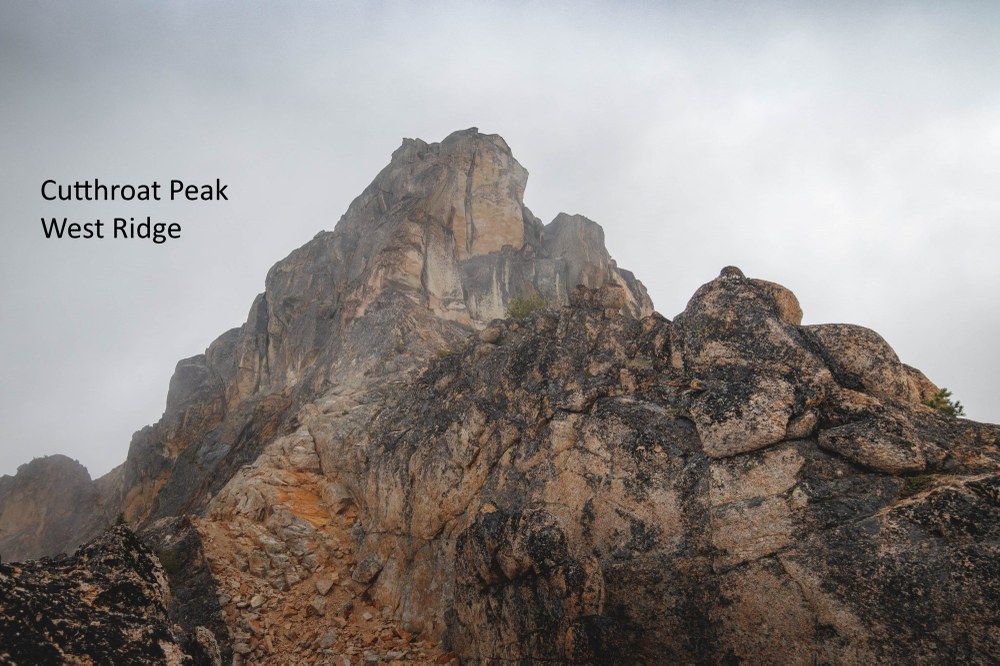
As Mountaineers, we are committed to learning from our experiences. We examine every incident that happens on a Mountaineers trip for opportunities to improve the ways we explore and teach. Our volunteer safety committee reviews every incident report and picks a few each month to share as examples of ‘Lessons Learned’. The trip report below describes what happened on this trip, in the leader’s own words, and outlines the lessons the leader has identified. In some cases, we offer additional key learnings from the incident.
Sharing incidents creates an opportunity to analyze specific incidents and also identify larger incident trends. We appreciate every volunteer trip leader who takes the time to share their incidents and near-misses so that others can benefit. We ask that readers engage critically and respectfully in the spirit of sharing and learning.
Cutthroat, West Ridge - 28 July
fROM THE INCIDENT DATABASE: LEADER INCIDENT REPORT
LEADER
On Sat. July 28, around 7:30am, a basic student was hit by a large rock at high velocity while approaching the West Ridge of Cutthroat peak. The cause of the rockfall is unknown.
We started our climb at 5:45am from Hwy 20, just west of WA Pass. There were no other parties ahead of us. There were two basic students on the climb and myself. We made fast work of the trail from the road, through the meadow, and into the cirque. We stopped at the top of the meadow, as the trail disappeared, and put on helmets. We began climbing a steep, sandy gully, to get to the "westerly most dirt gully" which would be our access point to the west ridge.
Between 6,800ft and 7,000ft, with all three members of the team standing close together, a rock flew down from above, nearly silently, and hit the basic student in the stomach. A flat face hit her, and she described it as being larger in width than her abdomen. She immediately doubled over, having had the wind knocked out of her. The rock was so quiet that both myself and the other student barely perceived it falling past us. This was the only rock we observed coming down the entire time we were in the cirque.
We assessed her condition and immediately determined that descent was the appropriate option. She had a large bruise on her stomach and described some nausea, much soreness, and later a headache. Internal bleeding was a concern, and after the adrenaline wore off we were unsure how well she would be able to move. Luckily, she was able to walk down totally unaided.
We drove to Mazama were we met with her fianceé, who is a Physician's Assistant.
As of Saturday at 7:30pm (12 hours post-accident) she is feeling well, all things considered, and has spent the day resting. She chose not to seek any further medical attention.
We were very lucky that the rock hit the student were it did. A few inches higher and she would likely have had broken ribs, and higher than that would have resulted in a very different incident report.
LESSONS LEARNED
LEADER
I went to the Goat's Beard in Mazama, and spoke with someone with a lot of knowledge of the area (I don't know his name, but he has a ponytail and is often working there). He said that he hears stories "all the time" about people being hit by rocks on Cutthroat. He emphatically (and vividly) described it as bad place to climb. Both the West Ridge and the South Buttress. In particular, he described this type of rockfall as common on Cutthroat.
Rockfall is an objective hazard of climbing in the mountains, but it is worth considering whether the West Ridge should still be a run as a basic climb. If yes, the approach should be modified to be safer, perhaps approaching from the east.
Add a comment
Log in to add comments.While our trip reports mention rock fall hazard the route description doesn't. It should be updated.
Thank you for sharing this. Can we also note this on the route description page for both West Ridge and South Buttress similar to mention the rock fall danger for Mount Shuksan/Scramble route?
I added notes to the West Ridge route/place. It is notorious for loose rock and potential rockfall. It's also an alternate descent route for our Southeast Buttress and North Ridge routes, so I added notes about loose rock on the West Ridge to those. I've climbed the Southeast Buttress a couple times and recall only solid rock and great climbing. The one trip report we have supports this, so I did not add a note about loose rock on this route. There are no trip reports for the North Ridge. If anyone has done this recently, please let us know the quality of the rock and if we should add notes about loose rock. Thanks!
CB Thomas is the Goat's Beard climber mentioned in this report. He and others are correct in noting the unsafe rock on this route. Back in the 1980s sometime,Steve Barnet and I turned back after noting the outsloping rock strata.
 David Shema
David Shema